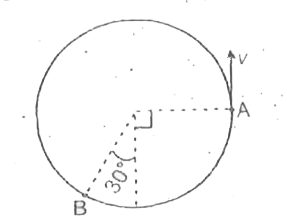A body of mass 10 kg moves with a constant speed v of 2 ms−1 along a circular path of radius 8 m. The power produced by the body will be
10 Js−1
98 Js−1
49 Js−1
zero
The correct Answer is:D
(d) Power is defined as the rate of change of energy in a system or the time rate of doing work.
⇒ P=dEdt=dWdt Also, work =force×displacement=F×d
Since, the displacement is zero,
so, P=ddt(F×d)=ddt×0=0
Topper's Solved these Questions
- BOOK - DC PANDEYCHAPTER - WORK, ENERGY AND POWEREXERCISE - EXERCISES(TAKING IT TOGETHER)83videos
WORK, ENERGY AND POWER
- BOOK - DC PANDEYCHAPTER - WORK, ENERGY AND POWEREXERCISE - MEDICAL ENTRANCE SPECIAL QUESTIONS16videos
WORK, ENERGY AND POWER
- BOOK - DC PANDEYCHAPTER - WORK, ENERGY AND POWEREXERCISE - CHECK POINT 6.220videos
WORK, ENERGY AND POWER
- BOOK - DC PANDEYCHAPTER - WORK, ENERGY & POWEREXERCISE - Level 2 Comprehension Based2videos
WORK, ENERGY & POWER
- BOOK - DC PANDEYCHAPTER - WORK, POWER AND ENERGYEXERCISE - E Integer Type Questions11videos
WORK, POWER AND ENERGY
Similar Questions
A particle of mass m moves with constant speed v on a circular path of radius r as shown in figure. The average force on it during its motion from A to B is
 View Solution
View SolutionA particle of mass m moves with constant speed v on a circular path of radius r. Find magnitude of average force on it in half revolution.
View Solution
Knowledge Check
- Question 1 - Select One
A body of mass 1kg is moving with a uniform speed of 1m/s in a circular path of radius 1m. The external force acting on the body is
A1NB1 dyneC1JDzero - Question 2 - Select One
A body moving along a circular path has
Aa constant speedBa constant velocityCno tangential velocityDno radial acceleration - Question 3 - Select One
A body moving along a circular path has
Aa constant speedBa constant velocityCno tangential velocityDno radial acceleration.
When a body moves with a constant speed along a circle
View SolutionA particle of mass 'm' moves with a constant speed along a circular path of radius r under the action of a force F .Its speed is given by
View SolutionA particle of mass M moves with constant speed along a circular path of radius r under the action of a force F. Its speed is
View SolutionA body moves with a constant speed along a curved path its acceleration :
View SolutionA body moves with a speed of 2πms−1 in a cirular path of radius 1 m , then the time taken to compete one revolution is ________.
View Solution

